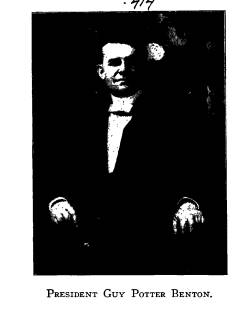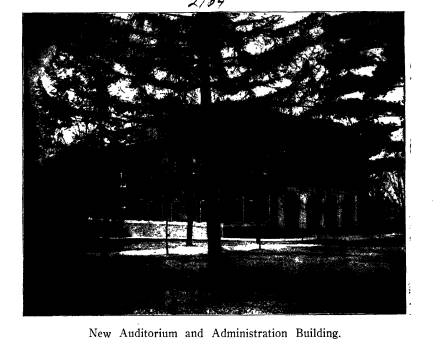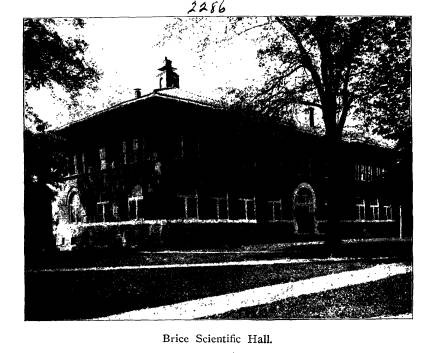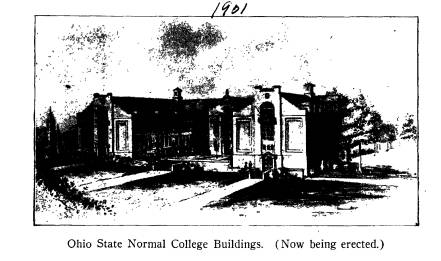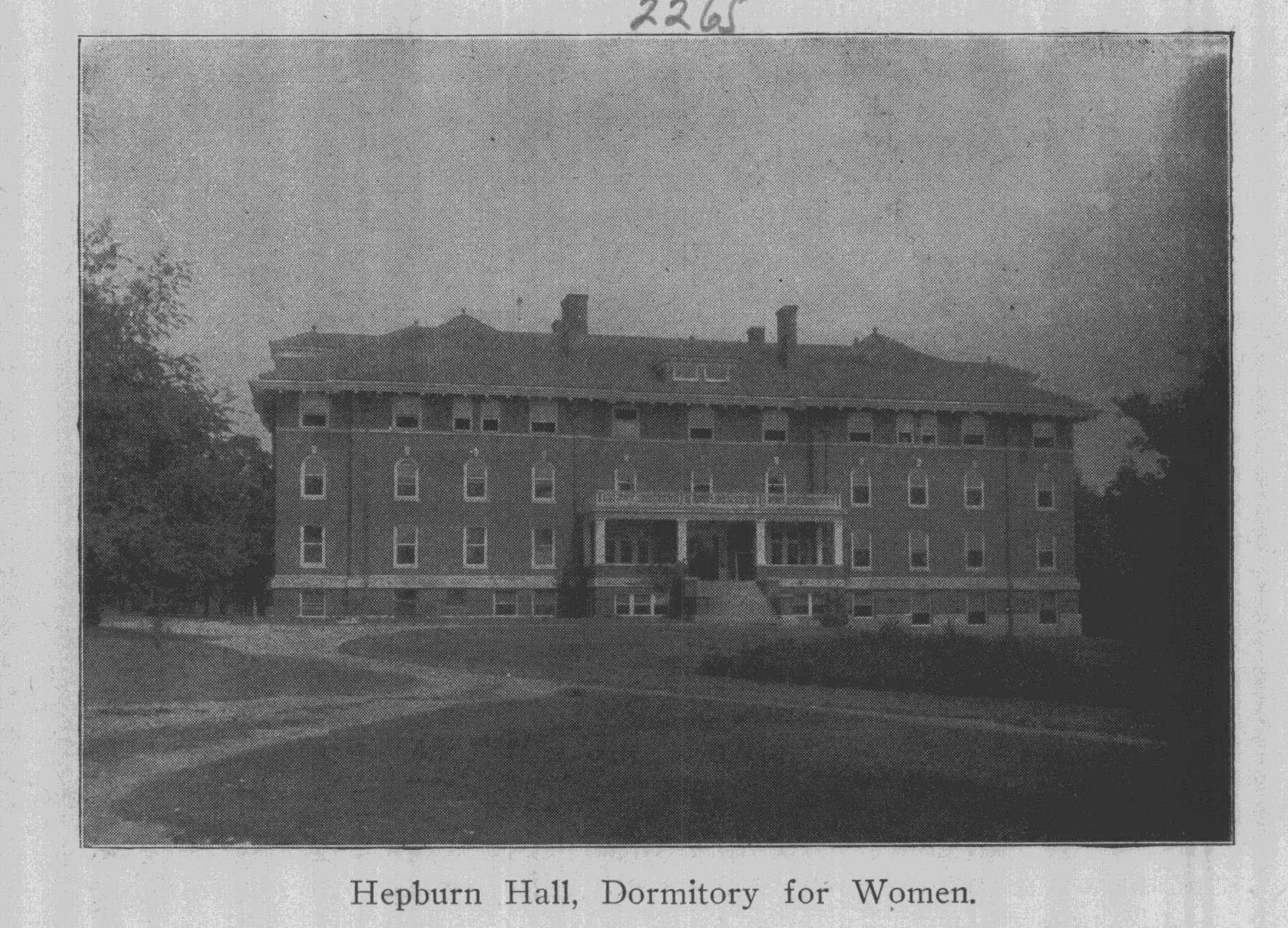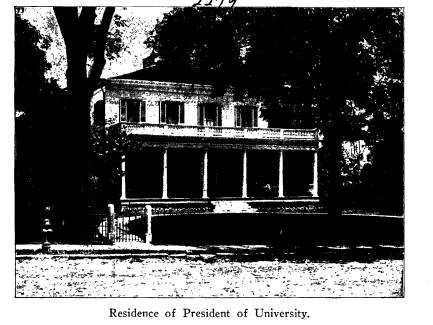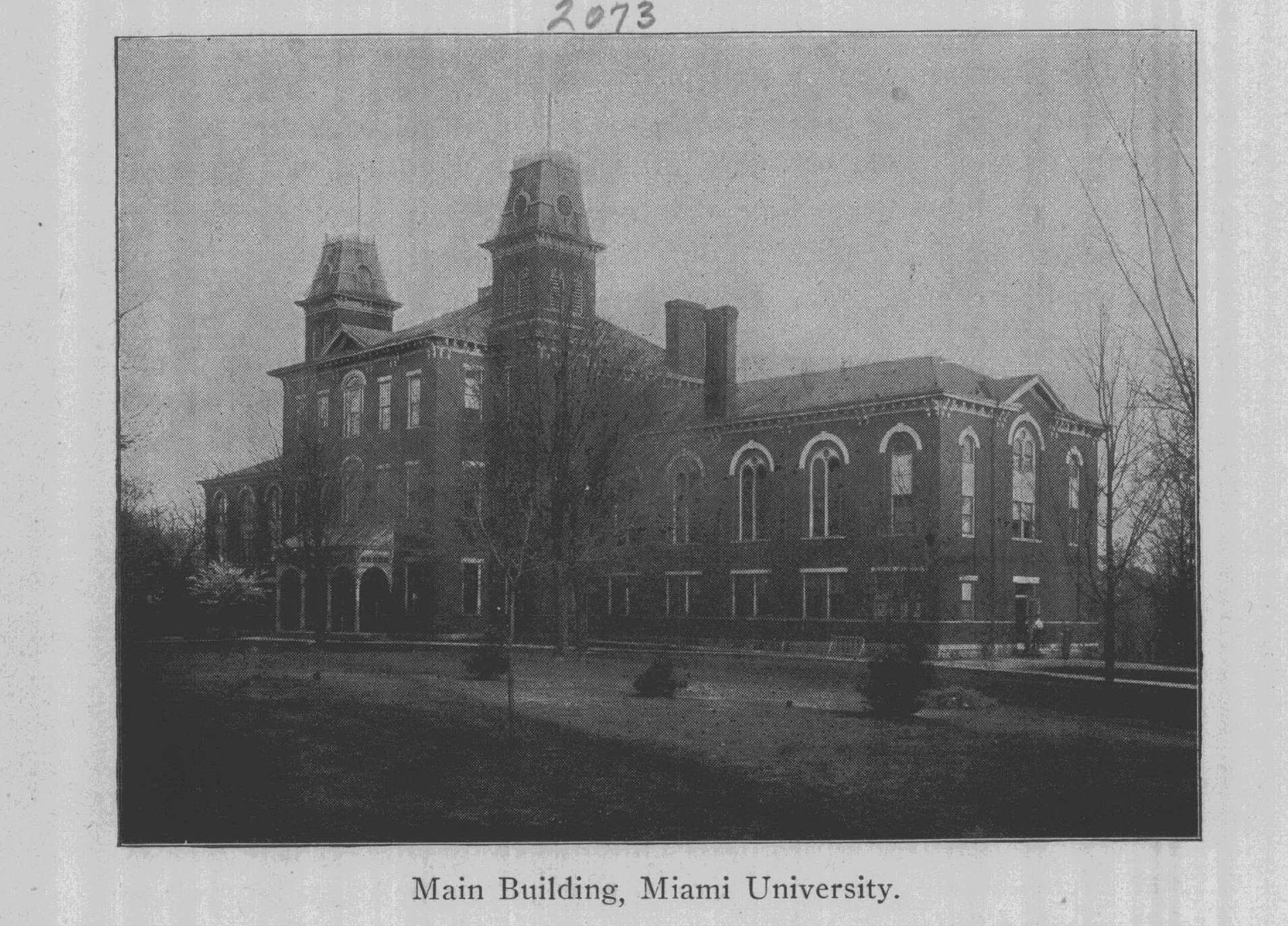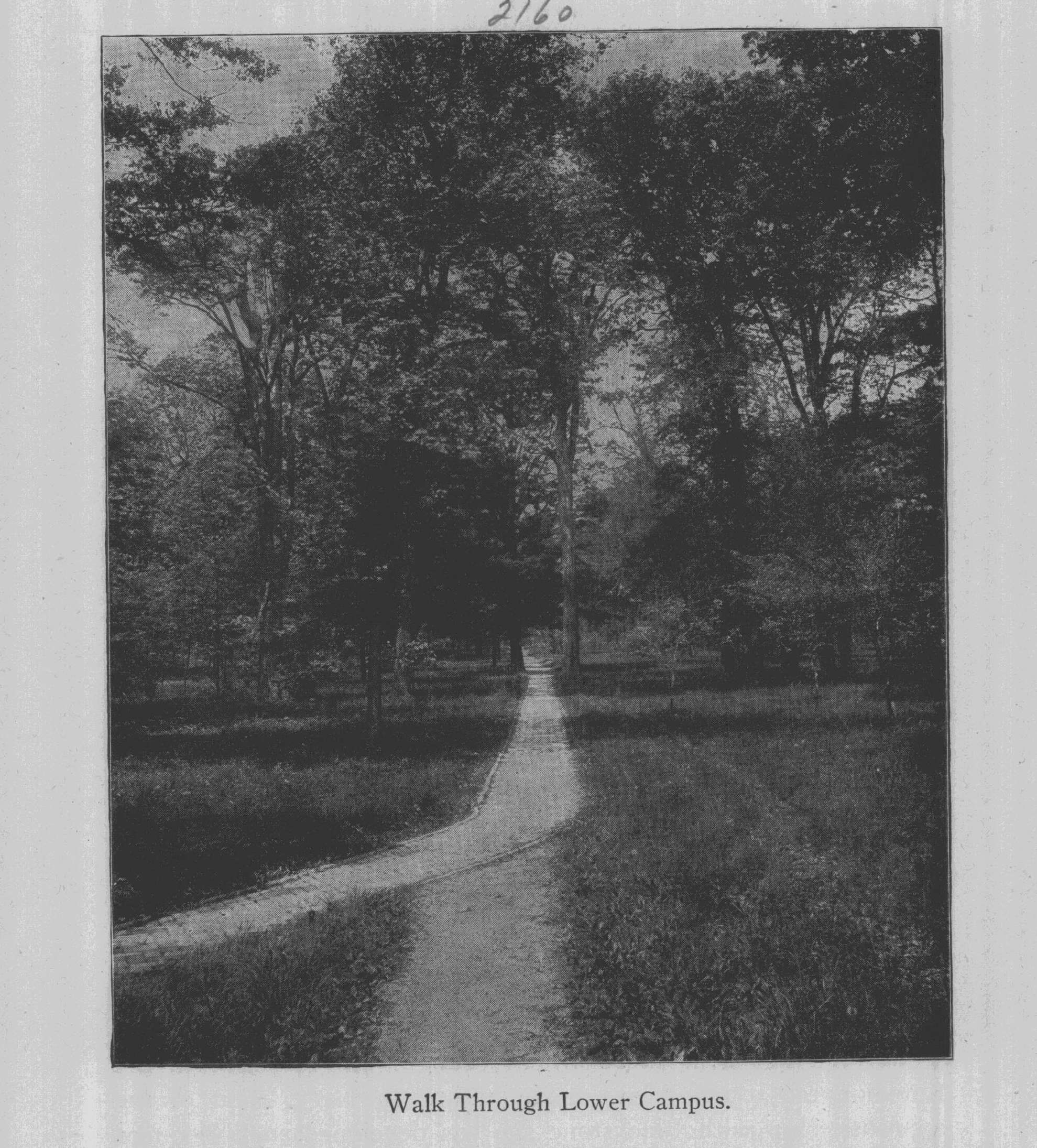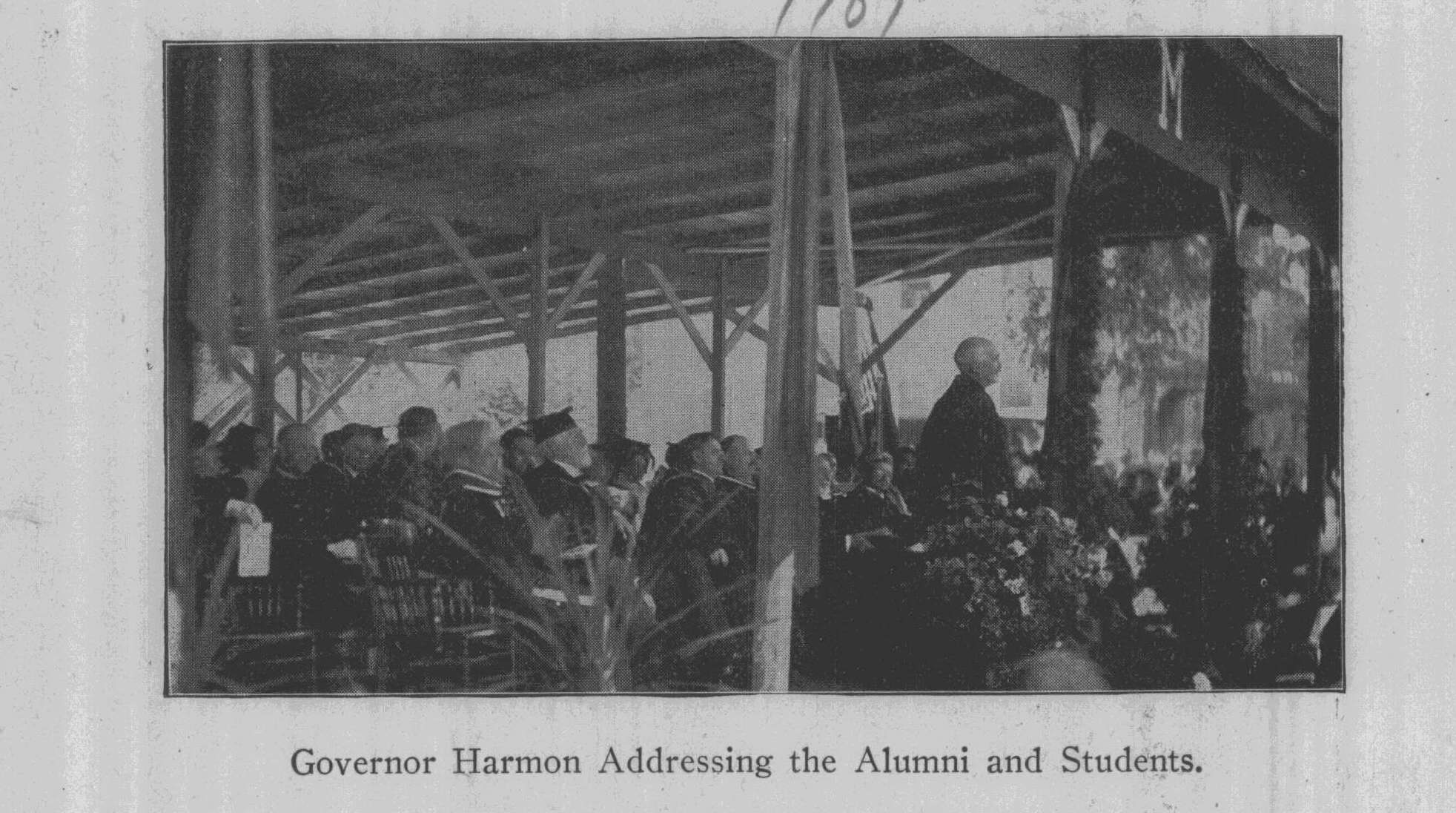Ohio History Journal
|
THE CENTENNIAL OF MIAMI UNIVERSITY.
A. H. UPHAM,
PROFESSOR OF ENGLISH, MIAMI UNIVERSITY. The third week of June was marked by a highly significant and somewhat unusual occasion down in the southwest corner |
|
of Ohio. Miami University, old mother Miami, was cele- brating the completion of her first centenary of cor- porate existence; and he r children, unto the third and f o u r t h generation, came from the corners of the earth bringing t r i b u t e of congratulation a n d g o o d wishes. The village of Ox- ford was in holiday attire; but festooned bunting seemed tawdry and common- place against the rare old- fashioned b e a u t y of the wide, s h a d y streets, the green inviting door - yards, and the leafy vistas of the University ground s. The |
|
weather was nearly -if not quite - perfect, making it possible to do most of the celebrating out among the trees. The elaborate program for the week was carried out with most of the accessories that convention has attached of late to such affairs. One night the students made merry at the expense of the faculty, and paraded themselves about the campus burn- ing quantities of red fire. On other nights a select few of them did Shakespeare and the like before sweltering audiences, as a relief from the interminable speech-making. There were vari- 322 |
|
|
|
The Centennial of Miami University. 323
ous long processions of black gowns and mortar-boards, at which certain of the old-timers stood aghast, protesting vigor- ously that they didn't trifle with such things in their day. His Excellency the Governor was on hand to represent the Common- wealth, attended by his imposing retinue in tight uniforms and gold braid. There was music by the band and music by the glee club; then there were some more speeches. Honorary degrees |
|
|
|
were distributed with the somewhat liberal hand characteristic of such events. There was also a graduating class, much the largest in the history of the institution, but in the excitement it had the habit of slipping modestly into the background and be- ing lost to view. If anything was really lacking it was the general public- the uninterested, amusement-seeking public, that is. They had planned to come until word went forth that the only real live |
|
324 Ohio Arch. and Hist. Society Publications. President outside the African jungles would positively not be on exhibition. Then their attention wavered and they hurried off to Dayton to complain of the crowd and wait around in the hope that somebody would fly. Oxford was crowded almost to the limit of her accommodations, but not beyond; so that every- body was comfortable and in good humor. And the assemblage represented the past, present and future patronage of the Uni- |
|
|
|
versity; those who have followed her career through decades, who have a part in her present remarkable advancement, or who look to her with anticipation of close relationships soon to be. Miami was emphatically in the hands of friends and kindred, so that the occasion constantly resolved itself into a great informal love-feast. So much for surface appearances. But even the casual ob- server could not linger long about that animated campus without |
The Centennial of Miami
University. 325
realizing that, after all, the big thing
about the celebration was
not the general air of jubilee or
prosperous contentment. It was
the realization,-hard enough to express,
but pounding at the
heart of every visitor familiar with the
facts,-of all the years
of struggle with accumulated adversity
through which the little
old college has heroically progressed,
and the immense poten-
tiality Miami has been in the
development and refinement of the
Middle West. The story has been told
often within the past
year, from various points of view and
with various degrees of
completeness; but it is highly desirable
that the obvious facts
from the University's first century of
achievement should be at
least hurriedly summarized for those
intimately concerned with
the development of the commonwealth.
After negotiations extending over more
than seven years,
John Cleves Symmes received on September
30, 1794, letters
patent from the United States
Government, placing him and his
associates in possession of "All
that tract of land, beginning at
the mouth of the Great Miami river and
extending from thence
along the river Ohio, to the mouth of
the Little Miami river, and
bounded on the south by the said river
Ohio, on the west by the
Great Miami river, on the east by the
said Little Miami river,
and on the North by a parallel of
latitude -so as to compre-
hend the quantity of three hundred and
eleven thousand, six hun-
dred and eighty-two acres of land with
the appurtenances." Cer-
tain specific reservations were made
from this "Symmes Pur-
chase," one of the most important
reading as follows: "It is
hereby declared, that one complete
township or tract of land, of
six miles square, to be located with the
approbation of the gov-
ernor, for the time being, of the
territory northwest of the River
Ohio, and in the manner and within the
term of five years afore-
said, as nearly as may be, in the center
of the tract of land here-
inbefore granted, hath been and is
granted and shall be holden in
trust to and for the sale and for the
exclusive intent and pur-
pose of erecting and establishing
therein an academy and other
public schools and seminaries of
learning, and endowing and sup-
porting the same, and to and for no
other use, intent or purpose
whatever."
This statement may properly be
interpreted as a national
|
326 Ohio Arch. and Hist.
Society Publications. guarantee of the perpetual maintenance of a college for the in- habitants of the Symmes Purchase, but to Symmes himself it meant just then a rather embarrassing situation. For this was not his first contract with the government. It was rather a sec- ond or third modification of the original document, in which also this academic reservation had appeared. Symmes had his lands on the market as early as November, 1787, and in his initial pros- pectus called attention to this college township even locating it definitely on the map. Somehow the revised grant of 1788 |
|
New Alumni Library Building. |
|
neglected to mention any township for academic
purposes, and the portion first selected was soon divided up with
the rest. So the final contract found poor Symmes with no full
township at hand that would satisfy the requirements; and a neat
little tri- angular controversy ensued, involving Symmes, the
Congress of the United States, and the territorial governor, to
whom had been delegated the responsibility of selection. The question was still pending when Ohio took on the
digni- ties and perquisites of statehood, one of which was
the perpetual stewardship of these rather hazy thirty-six sections
of college land and the institution to profit therefrom. Finally
if was |
The Centennial of Miami
University. 327
necessary to settle upon a tract
entirely outside the Purchase,
but in the so-called District of
Cincinnati - the unsold portion of
Oxford Township and two and one-half
sections adjoining.
This settlement was not to go into
effect for five years, in the
hope that during the time an available
complete township might
turn up somewhere within the Symmes
land.
Accordingly it was 1809 before the state
of Ohio formally
created The Miami University, provided
for the Trustees and
Faculty, drew up a charter of rights and
privileges, and arranged
to make the lands productive of funds
for maintenance. These
provisions were made by an act of the
Legislature, February 17,
1809. With this act began the legal
career of the University,
recognized without reservation as an
institution of the State of
Ohio. It was a long way from this
Legislative document and
thirty-six sections of unbroken timber
and undergrowth to a
smoothly running educational machine.
People didn't yearn
greatly for these lands at first, under
the terms of lease pro-
vided by the state. These leases were to
be for ninety-nine
years, renewable forever, and the
tenants were to pay an annual
rental of six per cent on the land value
of their property, with
a revaluation every fifteen years. Then
the state, with a com-
mendable desire to get things going but
a sad misconception of
future needs, repealed the clause
regarding revaluation, fixing
the land rent to the University forever
at the rate of six per cent.
on the original valuation. Hence it is
that during the long
heart-breaking years, while the state
denied further aid, the uni-
versity struggled on desperately in a
cramped and half bankrupt
condition; and that nowadays, when the
state is conscientiously
administering the trust, these annual
land-rents are about suffi-
cient to maintain three professorships.
There was trouble for years over the
location of the actual
university, much as there had been over
those precious lands.
The creating act of 1809 definitely
appointed a locating commis-
sion, instructed to select a spot
"In such part of the John Cleves
Symmes Purchase as an eligible place can
be found." One com-
missioner failed to act, and the other
two agreed upon Lebanon,
Ohio, as the University site. At the
next session of the Legis-
lature, under various kinds of pressure,
the proceedings of this
|
328 Ohio Arch. and Hist. Society Publications. commission were declared void and the assembly itself fixed the location at the proposed town of Oxford, to be laid off and con- structed within the college township itself. Thus the state be- came the proud and inexperienced guardian of a young Univer- sity, begotten of the Symmes Purchase, but entirely outside the ancestral fences. Of course there was trouble. Various com- munities within the Purchase, whether they had ever had a chance at the College or not, began to feel that the Legislature had given them shabby treatment. Cincinnati in particular, who had been making several ineffectual efforts toward a seat of |
|
|
|
higher learning, took the matter much to heart, and planned two clever and well-nigh successful campaigns, in 1814 and 1822, to get the institution transferred to some point near the Ohio River. Everybody concerned felt that the University was getting under way too slowly. Just what they could have expected from a trackless area of inaccessible woodland isn't quite apparent. People could not be forced to buy the land, even at bargain prices; and many who did were undesirable citizens who paid only under pressure. A "missionary" was sent out into New England and the Atlantic States, not to carry culture or religion, but to solicit funds for the new Miami. He had a hard time of |
The Centennial of Miami
University. 329
it and accumulated little. Gradually
money was secured for
the erection of buildings, beginning
with the "school-house" that
cost one hundred and fifty dollars, and
culminating in a fairly
adequate college building, under
construction from 1820 to 1824.
By this time the income had accumulated
so as to justify the em-
ployment of a small faculty and the
initiation of college work.
Robert Hamilton Bishop, the first
President, was inaugurated
March 30, 1825, having undertaken the
duties of his office the
November previous. By the day of
inauguration the roster of
students had already grown from a mere handful at the
opening session to nearly a hundred; and
there was never a day
thereafter, while the portals were
thrown wide, that there were
not eager youths in considerable numbers
waiting to be taught
With the machinery once in actual
motion, Miami's skies for
a time continued clear. President
Bishop, a sterling Scotch
character with vigorous mind and
engaging personality, had as
sociated with him men capable of great
influence upon the pio-
neer country. Young McGuffey, fresh from
college, served here
his apprenticeship in teaching, and
conducted the experiments
out of which came finally the old
Eclectic Readers of blessed
memory. John W. Scott came early into
this group, before he
had tried his hand at imparting higher
education to young
women, or had a daughter old enough to
win the heart of a fu-
ture president. Three buildings -the two
present dormitories
and a little one-story Science
Hall,-were erected in Doctor
Bishop's time, bringing Miami into the
front rank among western
colleges in material equipment. So
careful indeed was the Doc-
tor's management of funds, that the
records of his administration
often show a surplus, sometimes as high
as $2,000.
In this period, too, ventures were made
in the direction of a
real university scheme, with
professional colleges. In 1827 it
was a law school that the Trustees
contemplated, and the Presi-
dent was authorized to prepare plans for
the work and look out
for a competent professor. For some
reason this was dropped,
and in 1830 a medical school was the
focus of attention. This
time a dean was actually selected and
empowered to choose his
colleagues, and announcements were
printed and circulated.
|
330 Ohio Arch. and Hist. Society
Publications. The Ohio Medical College at Cincinnati protested, and
by some timely maneuvering this project also came to be
abandoned. Prosperity and large attendance did not necessarily
mean academic calm in the student community, as was
illustrated all too well in the late 30's. Many turbulent spirits
were there and discipline was a serious question. Even the literary
societies, powerful factors for good as they were, held charters
from the state and challenged openly the right of the faculty
to interfere |
|
Herron Gymnasium. |
|
in their proceedings. Finally, after sixteen years of
service, it seemed best that Doctor Bishop should resign his
executive post, take a place on the faculty, and let some stricter
disciplinarian try his hand. Choice fell upon George Junkin, President
of Lafay- ette College, who was noted for his firm will and had
just dis- tinguished himself on the Old School side of the
controversy be- tween the two great branches of the Presbyterian
Church. In spite of the sterling qualities of Doctor Junkin
the ex- |
The Centennial of Miami University. 331
periment was not a success. The
transition from President
Bishop's somewhat milder methods was
perhaps too abrupt.
Then too the ex-president was still on
the ground, a constant re-
minder to his many partisans of what
they considered the unfair
treatment he had received. The choice of
so noted a Presbyter-
ian zealot turned the eyes of the other
denominations upon
Miami, and led to the charge in the
religious press that this state
institution was being managed solely in
the interests of the Pres-
byterian faith. The abolition movement
was then in vogue
throughout Ohio, gathering many Miami
people to its support.
Dr. Junkin, while an anti-slavery man,
was firmly opposed to a
rabid abolition, and took occasion to
say so freely in the coun-
cils of his church. This rounded out his
list of opponents, and
he withdrew in 1844 to resume his old
position at Lafayette.
In his stead came Erasmus D. MacMaster,
one of the deep-
est logicians and ablest orators of the
Presbyterian church.
Moreover, he was an ardent adherent to
the cause of abolition.
His greatest service to the University
was in the line of scholar-
ship, the curriculum being raised to a
level with the strongest in-
stitutions in the East. Soon after his
arrival he presented once
more to the Trustees plans for a
complete university, including
a Normal School and School of
Agriculture, with those profes-
sional schools considered earlier. His
weakness, in Miami at
least, appears to have been on the
personal side, for he seems
never quite to have won the hearts of
the undergraduate body.
Pestilence was abroad during his stay
and frequently threatened
and even visited the little college
town. Dissatisfaction among
the boys led to numerous open outbreaks,
one of these resulting
in an almost wholesale expulsion from
the student ranks.
The administration of William C.
Anderson, from 1849 to
1854, was in many respects the most
prosperous in the early his-
tory of the University. The enrollment,
which was down to
sixty-eight when he came, increased
rapidly to over two hundred
and fifty. Yet intellectual standards
were in no sense depreciated
and hard work was the order of the day.
The faculty grouped
about him were men of unusual
attainments and influence. Doc-
tor Moffat held the chair of Latin until
recalled to Princeton,
when he was succeeded by young Robert
Bishop, destined to serve
|
332 Ohio Arch. and Hist. Society Publications.
more than a generation of loving usefulness in that position. David Swing followed Bishop in the Preparatory School. Pro- fessor Elliot, scholarly and absent-minded, wrestled with the problem of Greek. Stoddard, afterward of Wooster, presided over the queer little Science Hall, and Doctor Wylie, for years the grand old man of Indiana University, came in 1852 as Pro- fessor of Mathematics. All these men, with Doctor Anderson at their head, were great religious teachers, and Miami under their care experienced a spiritual awakening remarkable in its |
|
|
|
fervor and extent. Divisions and ill-feeling were unheard of, and financial adjustments could still be made. Still there was trouble enough ahead. John W. Hall was the war president, his term of service ex- tending through to 1866. Strangely enough, he was of South- ern blood and training, yet so fair-minded and free from parti- sanship that he remained an effective leader throughout all the great national struggle. There were plenty to suspect and criti- cise him, and finally his resignation came as others had before |
The Centennial of Miami
University. 333
him. But many of the arguments used for
his undoing involved
matters entirely out of his control.
Thus it was urged that at-
tendance fell off sadly, interest in
college work declined, dis-
cipline was lax. What else could be
expected of those stormy
years when Miami gave freely of her
best, and those left behind
were frantic in their longings to join
comrades at the front.
Money became again a serious issue. The
old college curriculum
began to seem inadequate to many people,
who clamored vigor-
ously for expensive modifications and
enlargements. Some of
these were indeed attempted. A
Normal-English course was
maintained for a time with a professor
all its own. A gymna-
sium was opened on a limited scale and
an instructor added.
Practical Engineering was also
undertaken. Modern Languages
were offered for a time as a substitute
for Greek, and unsuc-
cessful steps were taken to endow a
chair of English Literature,
to be occupied by the brilliant thinker
Swing.
Funds were if anything even lower at
this time than for
years before. During the war, for
instance, it was necessary at
least once to reduce the salaries of all
the instructors pro rata,
the reason given being "the present
condition of the country and
the existence of the Civil War, the
consequent depreciation of the
value of property and reduction of the
prices of living, and the
inevitable diminution of the income of
the University." In 1865,
there was favorable consideration of a
proposition from the Pres-
byterian Synod of Ohio, to direct their
endowment funds to
Miami rather than to the founding of a
new denominational col-
lege at Wooster. The Miami Trustees were
about to accede to
the stipulations involved, when it was
discovered that these
would require an amendment to the state
constitution, and so the
old University continued the peculiar
property of the common-
wealth.
President Robert L. Stanton came to
Miami in 1866, with
no disposition to dodge issues or to
mince matters in discussing
them. The institution was in sore
straits, impoverished in the
midst of an impoverished land. Students
had fallen off in great
numbers, and with them the very
essential tuition fees they
brought. The old buildings, however
staunchly erected half a
century before, were sinking into
decrepitude. Rival colleges
|
334 Ohio Arch. and Hist. Society Publications.
had sprung up all about, and the demand of the day was for larger faculties, new courses of study--particularly in the sciences, with their expensive equipments, - and ample and com- fortable quarters for the college community. Doctor Stanton worked hard and for a time appeared successful. Alumni and friends of the College raised a fund of nearly twenty thousand dollars to be expended on the buildings. Every session of the Legislature was besieged by petitions for a little further aid to |
|
|
|
complete the work begun, and there was always a remote possi- bility that something might be granted. Everything available was seized upon. The United States arranged for military in- struction in a few colleges, and Miami bestirred herself and was one of the first on the accepted list. Ohio paid tuition for such of her soldier sons as desired college training, and a few of these helped swell the little column of assets. For a time Miami hoped great things of the land-grant funds provided by the national government for state agricultural colleges. Every effort was |
The Centennial of Miami
University. 335
made to get this new educational work
and the accompanying in-
come divided between the two state
colleges already existing.
The legislature decided otherwise,
however, and established a
third state institution, at Columbus, as
the Agricultural College.
By the time that Doctor Stanton,
defeated and discouraged,
retired in 1871 in favor of Professor
Hepburn of the faculty, the
fate of Old Miami, for a time at least,
appeared settled. Even
a last resort had failed, an attempt to
consign the whole institu-
tion, on almost any terms, to such
religious denomination as
would refit it, endow it, and put it on
its feet again. So it was
generally agreed to cease work for a
time and allow the regular
income to accumulate, as it had in those
preliminary years be-
fore 1824. As this income was still
limited by legislative enact-
ment to little more than it had been in
pioneer days, while the
scope and expense of college efficiency
had magnified many fold,
the prospect was not particularly
pleasing at its best. Anyhow
the doors were closed to college classes
with the Commencement
of 1873, and the buildings relegated to
the uses of a private acad-
emy, conducted first by Professor Bishop
and afterwards by
Trufont and Marsh.
In 1885 the friends and well-wishers of
Miami could wait
no longer. They began to realize what
those of the present day
are having constantly brought home to
them, that this widening!
gap in the activity of the school was
certain to be felt seriously
later on, when callow graduates grew
into prosperous middle-
aged men of affairs, capable of helping
Alma Mater. Anyhow
Miami had money in the bank and
influential friends at court
just then. Why delay? With a loud
flourish of trumpets the
old weather-beaten machinery was set in
motion again and the
University began to make up for lost
time. Truly a new era was
dawning. For the state at this point
gave up the played-out role
of responsible but disinterested
administrator, acknowledged the
duty to support her ward, and made a
first appropriation of
$20,000 for buildings and repairs. During the two years of
reorganization, Doctor McFarland,
formerly the Professor of
Mathematics, occupied the president's
chair, with the understand-
ing that he was not a candidate for
permanent appointment.
Four other presidents have served since
this formal re-
|
336 Ohio Arch. and Hist. Society Publications.
opening: President Warfield, now of Lafayette; President Thompson, now of Ohio State University; Doctor Tappan, now preaching at Circleville; and the present incumbent, Doctor Guy Potter Benton. Throughout their administrations advancement has come with rapid strides, the state showing gradually in- creased liberality and the institution responding with promptness and enthusiasm. The faculties have been of young and progres- sive specialists, trained in the best graduate schools and satis- |
|
fied with nothing short of the highest scholarship. Buildings and equipment have steadily improved and the students have ap- peared in constantly increasing numbers. There have of course been occasions of dissension and dis- couragement, to each of which the new Miami has risen superior.. A few fundamental changes of policy have been adopted in these last years. The doors have been opened to young women on equal privileges with the men, and they have come to form ap- proximately one-fourth of the Liberal Arts enrollment. A State |
The Centennial of Miami
University. 337
Normal College has been instituted and
is in thriving condition,
being fitted out as rapidly as possible
with its own buildings and
equipment. The old name Miami
University, always a misnomer
in the strictest sense, is still
retained as the corporate title, hav-
ing gained a sentimental reverence
through the years. But no
one thinks of making Miami more than a
college, and a small
college at that:-the high-grade small
college representing the
best system of higher education yet
devised in the east or west.
This has been a long arid recital of
ancient history and you
are lucky if you have weathered through
it. But the aim has
been throughout to make clear to the
reader the environment of
discouragement and enforced poverty
through which little old
Miami plodded heroically to this
auspicious completion of her
first centenary. The remarkable thing
about it, however, is not
merely that Miami has completed this
century of years amid
adversity. Many an ordinary turtle lives
a great deal longer,
and progresses with much difficulty too.
The thing that should
direct the eyes of all Ohio to this
Centennial celebration is the
inestimable services the University has
rendered, directly and
through her alumni, in the development
of the state and of the
nation. There is but one way to get at
such a proposition: by
marshalling in rapid review before the
reader, with a mere apol-
ogy of a system, a small assortment of
the Miami men whose
lives have meant something for humanity.
"The pioneers of southwestern
Ohio," said Chancellor Mac-
Cracken, of New York University, in his
Centennial Address,
"were of near a dozen different
national stocks, but mainly non-
English Puritans. They were largely of
Scotch and Scotch-
Irish blood, like most of the early
graduates of Miami. Of the
twelve names of alumni of the
twenty-five classes from 1826 to
1850, who are still alive, ten are
Scotch or Scotch-Irish, from
McCaughan of 1837 to Andrew Brooks of
1850. Many grad-
uates were of Welsh blood, like Chidlaw,
Thomas E. Thomas,
and Senator Pugh. Others were Huguenots,
like the Monforts;
or Dutch, like Schenck and Groesbeck; or
Palatinate Germans,
like Shellabarger and Kumler: or they
were of English Vir-
ginia blood, like President Benjamin
Harrison. Miami was the
Vol. XVIII -22.
338 Ohio Arch. and Hist. Society Publications.
offspring of the highest intellectual
aspirations of a fusion of
Protestant races, mostly of Puritan
training, thrown together
upon the Ohio frontier."
From such material the various classes
of Doctor Bishop's
long administration were able, almost
without exception, to grad-
uate men who promptly achieved a
national reputation. Exam-
ples might be of interest.
1826. Ebenezer E. Pressly, founder and first
president of Erskine Col-
lege in South Carolina, and a leader in
religious work in the
south.
1827. Robert C. Schenk, foreign envoy,
congressman and brigadier-
general; finally ambassador at the Court
of St. James.
1828. William M. Thompson. minister and
foreign missionary; author
of "The Land and the Book."
1829. Ralph P. Lowe, governor of Iowa.
James Reily, U. S. Minister to Russia.
1830. Thornton A. Mills, editor of the
Central Christian Herald and a
leader in the Presbyterian Church.
1831. Freeman G. Cary, founder and first
president of Farmer's Col-
lege.
Theophilus L. Dickey, Assistant
Attorney-General of the U. S.
Duncan F. Keener, president of the
Louisiana Constitutional con-
vention.
1833. Charles Anderson,
scholar-statesman; offered appointment as As-
sistant Secretary of State and served as
a war governor of Ohio.
Benjamin W. Childlaw, the great Sabbath
School missionary.
1834. William Groesbeck, congressman,
candidate for the presidency, and
counsel for President Johnson in his
impeachment trial.
John J. McRae, U. S. senator and
governor of Mississippi.
Joseph G. Monfort, editor of the Herald
and Presbyter.
Thomas E. Thomas, president of Hanover
College.
1835. Samuel F. Cary, temperance
lecturer.
William Dennison, was governor of Ohio
and U. S. Postmaster
General.
1836. James Birney, war governor of
Michigan and U. S. minister to
Holland.
1837. James B. Howell, U. S. senator
from Iowa.
1838. John S. Williams,
brigadier-general in the Confederate army and
U. S. Senator from Kentucky.
1840. George E. Pugh, U. S. senator from
Ohio.
1841. Charles H. Hardin, governor of
Missouri and founder of Hardin
Female Institute in Missouri.
Samuel Shellabarger, congressman and U.
S. minister to Portugal.
|
The Centennial of Miami University. 339 This list is only a fair forecast of the classes to
follow, ex- cept for certain splendid years of plenty, where it
seems that al- most every graduate passed into generous service for
his coun- trymen. Every profession, every walk of life found
men from Old Miami ready to do their part, and more, of the
work at hand. The Christian ministry perhaps claimed the largest
share of these early graduates, many of whom labored faithfully in
some ob- scure corner of the vineyard till the close of day.
Several, how- |
|
Lower Campus, Miami University. |
|
ever, became famous and influential preachers in the great city churches, like James Hall Brooks in St. Louis or David Swing in Chicago. Many found careers in colleges, more than a dozen becoming able college presidents, as have David A. Wallace at Muskingum and Monmouth, Samuel S. Laws at Missouri State University, and Henry M. MacCracken at New York University. Law, statesmanship, and public life in general attracted many of them, as might be expected of youths trained so thor- |
340 Ohio Arch. and Hist.
Society Publications.
oughly in the give-and-take of the old
Literary Halls. One pres-
ident of the United States heads the
list of these-Benjamin
Harrison of the class of '52. Behind him
troops a respectable
following of cabinet officers and
ambassadors to foreign lands.
Of the first type not already noted may
be named Caleb B.
Smith, Secretary of the Interior in
Lincoln's first cabinet; Wil-
liam H. H. Miller, Attorney General, and
John W. Noble, Secre-
tary of the Interior, under Harrison.
Most prominent of
Miami's diplomatic representatives in
recent years is Whitelaw
Reid, former minister to France and now
ambassador at the
Court of St. James.
The list of governors of states is an
imposing one, and the
faithful alumni secretary is still
unearthing new ones from time
to time. Five famous war governors are
included: Dennison
and Anderson of Ohio, Morton of Indiana,
Yates of Illinois, and
Birney of Michigan. The noted lecturer
Will Cumback, for-
merly lieutenant-governor of Indiana,
was a Miami man, and
Governor Harris of Ohio, recently
retired, brings the list down
to date. The most recent of Miami's U.
S. Senators was Cal-
vin S. Brice, who died in 1897. The
lower house of Congress
nearly always had Miami men in it, so
that the task of citing
them would be almost as lengthy as to
enumerate state legisla-
tors, common pleas judges, or plain
everyday college professors.
It has been seen how the Civil War broke
into the academic
calm of Miami, situated as she was so
near the border. There
were many lads from the South in
attendance up to that time,
and the University gave freely to both
parties in the struggle.
Several of our great eastern
universities have made much of their
patriotic service in the rebellion,
commemorating it with Soldiers'
Fields and splendid Memorial Halls. But
figures show beyond
doubt that of all the colleges then
active in America, little Miami
sent by far the largest proportion of
her students and alumni into
service. They did service too, even the
youngsters fresh from
Euclid, in a way of which the state may
be always proud. Many
of them fought along in the obscurity of
the ranks; but a sur-
prisingly large number rose to
conspicuous heights.
By the end of the war, half a score of
Miami men had at-
tained the rank of General in the Union
army. The roster is
|
The Centennial of Miami University. 341
worth looking at: Robert N. Adams, Charles E. Brown, Joe Fullerton, Benjamin Harrison, Joseph B. Leake, John W. Noble, |
|
Ben P. Runkle, Robert C. Schenck, Gates P. Thruston, Durbin Ward. Robert N. Stemble became a rear admiral in the Union navy, and Stephen C. Rowan rose before his death to the rank |
|
342 Ohio Arch. and Hist. Society Publications. of vice-admiral. Humphrey Marshall and "Cerro Gordo" Wil- liams did conspicuous service in the Confederate army, both having the rank of brigadier-general. Samuel C. Smith, class of '36, was surgeon-general for the state of Ohio. Many of these promotions came for deeds of heroism on the field of battle. Other heroic deeds brought no such reward, for the boyish dare- devils who performed them lay still and lifeless when the day was done. Millikin and Falconer at Stone River; James H. Childs at Antietam; Joe Battle borne in Confederate gray through the camp at Shiloh: - Miami paid dearly of the bloody toll of war. |
|
Since the stormy '6o's Miami has never relaxed for a mo- ment in her large and efficient service for humanity. Perhaps the only difference in the last generation or so is that with the growing divergence of specialized occupations the University has distributed her sons more widely, clinging less closely to the time-honored triad of law, medicine and ministry. Out of the apprenticeship with Blackstone she has developed such eloquent and graceful orators as Samuel F. Hunt and George R. Wend- ling, as well as the famous law librarian of New York City, Wil- liam Huffman Winters. In medicine she has produced numer- |
The Centennial of Miami University. 343
ous specialists who have added valuable monographs to
scien-
tific knowledge, men like James T. Whittaker and S. C.
Ayres.
Most famous of her sons in this field is John Shaw
Billings, the
leading medical librarian of the country, and now at
the head of
the New York Public Library.
All the arts have found her ably represented, even in
these
latest years. The artist James Carter Beard, the
eminent
musician of the northwest Alfred M. Shuey, the critic
William
Sloane Kennedy, the artist-architect Heistand, the
brilliant news-
paper and magazine correspondent Edwin Emerson, and the
ris-
ing young poet and dramatist Ridgeley Torrence, have
all of
them spent their apprentice years with old mother
Miami, and
bear evidence to the versatility of her product. Robert
B. Stan-
ton and Philip N. Moore, in New York and St. Louis
respec-
tively, rank among the first of civil and mining
engineers. Busi-
ness and finance have claimed many of the ablest minds
from
Miami, among them William Beckett, the pioneer paper
manu-
facturer; A. C. McClurg, founder of the great Chicago
Pub-
lishing house; John H. Patterson, of National Cash
Register
fame, and Senator Brice, the railroad magnate.
Some years ago the alumni secretary of the University
com-
piled statistics of the Miami men, producing a table of
the deep-
est significance to all who concern themselves with the
possibili-
ties of a small college or have ever questioned the
justification of
such an institution's existence. The result is
appended.
PUBLIC OFFICES.
Presidents of the
United
States.................... ..... 1
Governors of States
................................... 10
Lieutenant-Governors
.................................... 2
Cabinet Officers .................... .................... 3
Foreign M
inisters ....................................... 5
Attaches and Consuls ........................... ...... 1
United States Senators .................................. 7
Congressmen ........................................ 23
State Senators
........................................... 30
State
Representatives
....................................
69
Federal, State, County and Supreme Court Judges........
53
United States Army Officers with the Rank of Captain
and
above
.............................................
66
344 Ohio Arch. and Hist. Society
Publications.
EDUCATIONAL
POSITIONS.
College
Presidents ....................................... 30
College Professors,
etc ...................................
76
City and
County Superintendents ........................ 52
Other
Teachers ........................................ 116
GENERAL
OCCUPATIONS.
Teachers
................................................ 274
Lawyers
............................................... 327
M
inisters
................................................ 313
General
Business ....................................... 111
Physicians ............................................... 122
Editors and
Journalists .................................. 50
Authors ................................................. 50
Farmers ................................................ 80
Bankers ................................................. 13
Manufacturers
........................................... 17
Engineers
............................................... 24
At that time
the total number of Miami graduates was 1,826.
Thanks to the
reader's patience the purpose of this paper is
at last
accomplished; the task of showing what was really in the
hearts of
loyal Miami men, as they strolled idly but fondly be-
neath the
elms and walnuts on this recent centennial occasion.
The hope is
that everyone who worries through the detail may
feel with
them that the glory of Old Miami is not to have lived
one hundred
years, but to have survived such hardships and dis-
couragement
and to have produced and effected so much.
